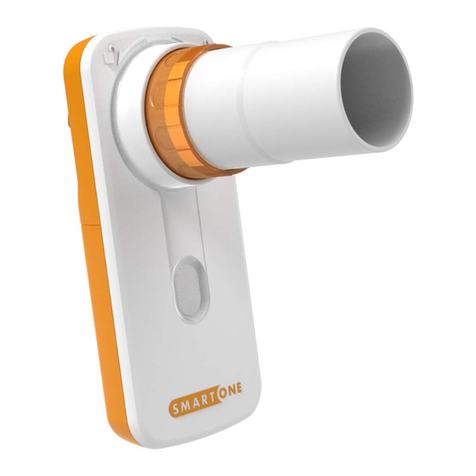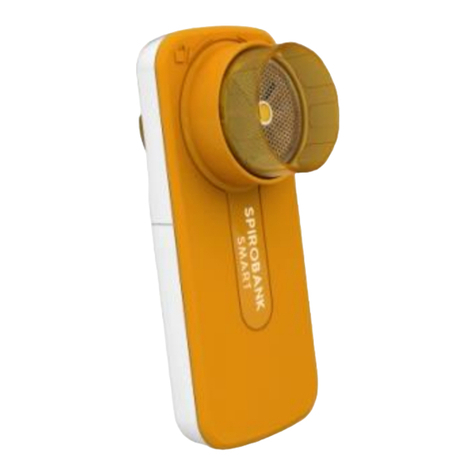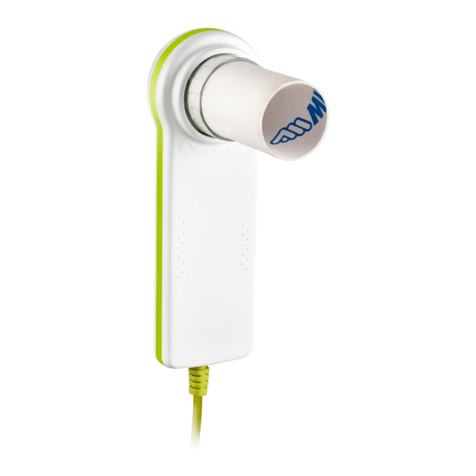
spirodoc user manual code 980165 Rev 4.5 page 3 of 27
INDEX Page
1. INTRODUCTION......................................................................................................................................................... 4
1.1 Intended use ...................................................................................................................................................... 4
1.1.1 User category............................................................................................................................... 4
1.1.2 Qualification and experience required ......................................................................................... 4
1.1.3 Operating environment ................................................................................................................ 4
1.1.4 Who must/can make the installation............................................................................................ 4
1.1.5 Patient effect on the use of the instrument .................................................................................. 4
1.1.6 Limitations of use – Contraindications ......................................................................................... 4
1.2 Important safety warnings................................................................................................................................ 4
1.2.1 Danger of cross-contamination.................................................................................................... 5
1.2.2 The turbine................................................................................................................................... 5
1.2.3 The mouthpiece ........................................................................................................................... 5
1.2.4 The Pulse oxymetry sensor ......................................................................................................... 5
1.2.5 The instrument ............................................................................................................................. 6
1.3 Unforeseen errors ............................................................................................................................................. 6
1.4 Labels and symbols .......................................................................................................................................... 6
1.4.1 Identification label ........................................................................................................................ 6
1.4.2 CE mark for medical devices ....................................................................................................... 7
1.4.3 Electrical safety symbol ............................................................................................................... 7
1.4.4 Warning symbol for the RS232 serial port................................................................................... 7
1.5 Product description .......................................................................................................................................... 7
1.6 Method of test interpretation............................................................................................................................ 7
1.7 Technical specifications................................................................................................................................... 8
1.7.1 Spirometer specifications............................................................................................................. 8
1.7.2 Pulse oximeter specifications....................................................................................................... 8
1.7.3 Other specifications ..................................................................................................................... 8
1.8 Spirometric normal values ............................................................................................................................... 9
2. OPERATION OF THE SPIRODOC............................................................................................................................. 9
2.1 Keyboard............................................................................................................................................................ 9
2.2 Battery level ..................................................................................................................................................... 10
2.3 To make a test ................................................................................................................................................. 10
2.4 Entering subject data...................................................................................................................................... 11
2.4.1 New subject data ....................................................................................................................... 11
2.5 Making a spirometry test ................................................................................................................................ 12
2.6 Making a spot oxymetry test .......................................................................................................................... 13
2.7 Making long term oximetry testing ................................................................................................................ 14
2.7.1 Adult Single Patient Sensor – Instructions for Use.................................................................... 14
2.7.2 Making a test.............................................................................................................................. 15
3. TEST RESULTS ....................................................................................................................................................... 15
3.1 Interpretation of the spirometry test.............................................................................................................. 15
3.2 Viewing the results.......................................................................................................................................... 16
3.3 Print out of the results .................................................................................................................................... 16
3.3.1 Print out...................................................................................................................................... 18
4. MAINTENANCE........................................................................................................................................................ 19
4.1 Cleaning and general control of the turbine ................................................................................................. 19
4.2 Replacement tape instructions ...................................................................................................................... 19
4.3 Changing the battery ...................................................................................................................................... 19
5. POSSIBLE PROBLEMS........................................................................................................................................... 20
5.1 Causes and solutions ..................................................................................................................................... 20
6. CONFIGURATION MANUAL FOR THE SPIRODOC............................................................................................... 21
6.1 Configuration menu ........................................................................................................................................ 21
6.1.1 Select Language........................................................................................................................ 21
6.1.2 Delete Test Data........................................................................................................................ 21
6.1.3 Oximetry: threshold values ........................................................................................................ 21
6.1.4 Oximetry: sampling rate............................................................................................................. 21
6.1.5 Date Format ............................................................................................................................... 22
6.1.6 Change Date/Time..................................................................................................................... 22
6.1.7 Predicted Values........................................................................................................................ 22
6.1.8 Unit Format ................................................................................................................................ 22
6.1.9 Select Printer.............................................................................................................................. 23
6.1.10 Store All Test (for future developments).................................................................................... 23
Declaration of EC Conformity ........................................................................................................................................ 24
Limited Warranty Conditions ......................................................................................................................................... 25
ANNEX 1 INFORMATION FOR CORRECT USE IN AN ELECTROMAGNETIC ENVIRONMENT .......................... 26

































